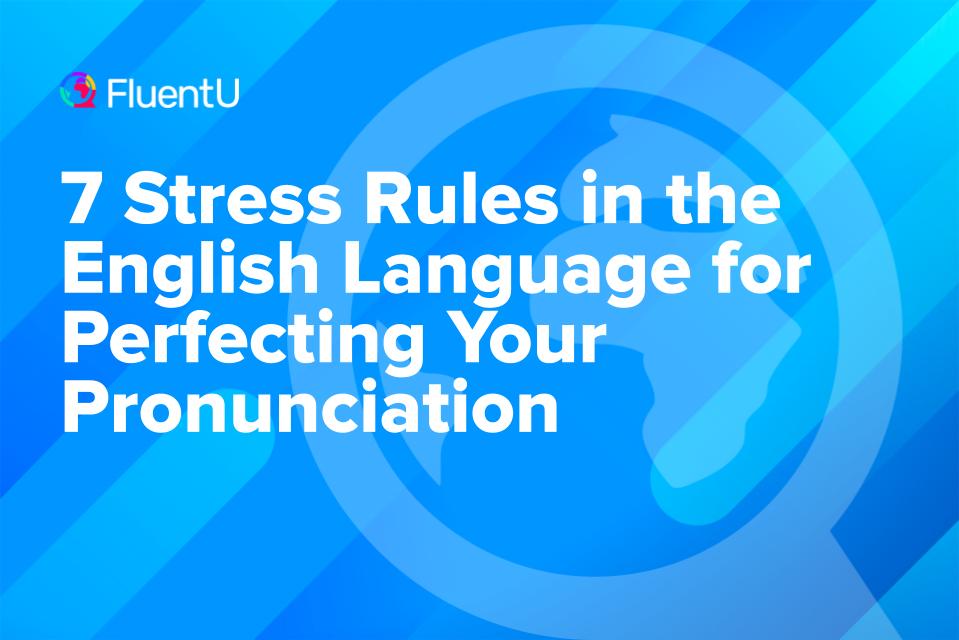7 Stress Rules in the English Language for Perfecting Your Pronunciation

English is a “stressed” language.
We’re not literally talking about how stressful English can sometimes be (especially with its contradicting rules!). What we mean is English stresses or emphasizes some words and syllables compared to others. They’re pronounced more strongly with higher pitch, and they even take more time to say.
In this sense, English has a melody. You can think of spoken English as more like a wave with ups and downs rather than a monotone.
This isn’t just an add-on, either – stress is so fundamental to English that a word with the wrong stress will sound funny (and even unrecognizable). Because of this, a key part of becoming fluent in English is learning how to apply stress correctly.
To make it easier for you, we’ve come up with the main stress rules in the English language that you should know about. Check them out in our guide below!
Download: This blog post is available as a convenient and portable PDF that you can take anywhere. Click here to get a copy. (Download)
Two Levels of Stress in English
When you stress a sound, here’s what exactly happens:
- You draw it out more and say it loudly
- The pitch rises from the previous sound
- Your mouth movements are more exaggerated
- You pronounce it clearly instead of mumbling
With unstressed sounds, it’s the opposite!
Stress is a consistent feature of the English language, and you’ll encounter it in two levels: word stress and sentence stress. Let’s go over both:
1. Word Stress
Word stress refers to how there’s one syllable that’s stressed over the others in every English word.
Here are some examples, with the stress on the bolded syllables:
- Afternoon
- Cookie
- Departure
- Invite
It’s much more rigid than sentence stress because using the wrong word stress can lead to a breakdown in communication. English speakers are likely to have a hard time understanding you, and they might even ask you to repeat yourself.
Each word always has the same syllable that’s stressed. In fact, sometimes word stress can change the meaning of a word. You might give someone a present (stress on the first syllable) or gift, but you can also present (stress on the second syllable) a proposal.
2. Sentence Stress
With sentence stress, you’re stressing or emphasizing specific words in a sentence over the others. It’s a bit more flexible than word stress because it depends on your intent – you can stress different words in a sentence based on what you want to highlight. However, there’s still a more standard way to do it.
Examples:
- Do you have an English class this week?
- We got stranded because it was raining hard.
- The world was so different centuries ago.
- They aren’t sure where they’re headed.
Sentence stress combines with word stress in practically every English phrase or sentence. To sound natural when speaking English, you have to include both smoothly.
Word Stress Rules in the English Language
Let’s start off with word stress rules. Although the same syllable is always stressed in each word, where this syllable is located varies from word to word. Some words will have their first syllable stressed, while for others, it’s the last or even the middle syllable.
These are the main word stress rules in English:
Rule 1: Nouns and adjectives usually stress the first syllable.
This is a useful rule because nouns and adjectives are among the most common words that you’ll encounter.
Nouns refer to people, places, and things.
Examples:
- Bottle
- Flower
- Library
- Ocean
- Pencil
Adjectives describe nouns and pronouns.
Examples:
- Happy
- Interesting
- Massive
- Modern
- Tasty
Rule 2: Two-syllable verbs and prepositions usually stress the second syllable.
Verbs are action words that describe what someone (or something) is doing. They can also refer to states of being (e.g. am, are, feel).
Examples:
- Approach
- Commute
- Maintain
- Perform
- Suggest
Prepositions convey how a noun or pronoun is connected to another word in a sentence. They can refer to location, direction, or time, among others.
Examples:
- Above
- Among
- Except
- Instead
- Until
Rule 3: Three-syllable verbs usually stress the first syllable.
If verbs have three syllables instead of two syllables, then most of the time, it’s the first syllable that’s stressed. This is actually true for most three-syllable words!
Examples:
- Celebrate
- Contemplate
- Decorate
- Entertain
- Innovate
Rule 4: Words ending in -ic, -sion, and -tion usually stress the second-to-last-syllables.
These are suffixes that are found at the end of the word, so the syllable right before is the one that’s stressed. This rule also applies to less common suffixes starting in I or U such as -ual, -uous, and -ial.
Examples:
- Compassion
- Decision
- Electric
- Imagination
- Rejection
Rule 5: Words ending in -cy, -ty, and -gy usually stress the third-to-last-syllables.
For this rule, just count backwards from the last syllable.
Examples:
- Agency
- Biology
- Fluency
- Society
- Security
Consider these as general rules – they work most of the time, but you’ll definitely still encounter words that don’t fit. Because of this, it’s still important to learn the pronunciation of words on an individual basis. However, you can use these word stress rules as a guide so you don’t get overwhelmed when trying to remember the stress for different words.
Sentence Stress Rules in the English Language
Once you can stress the right syllables in individual words, you’ll have to string the words together into a sentence. That sentence will also have its own stress!
Sentence stress rules are simpler, mainly because you can roughly figure out sentence stress by analyzing the sentence. They’re also much more intuitive, especially if your native language already uses a similar form of sentence stress.
These are two main sentence stress rules:
Rule 1: Content words are stressed.
Content words are essential to the meaning of the sentence. They generally include nouns, verbs (except for is, are, am), adverbs, and adjectives
These make up the meat of the sentence and convey important information. Here are some examples of content words:
| Nouns | computer, food, music, people, year |
| Verbs | call, live, pay, read, work |
| Adverbs | actually, almost, loudly, quickly, sometimes |
| Adjectives | amazing, confusing, important, old, real |
Content words are normally stressed in sentences:
- This is my favorite book.
- They were looking at which stocks to invest in.
- The flight from New York to Chicago just got delayed.
Rule 2: Function words are unstressed.
If a word isn’t a content word in a sentence, then it’s a function word.
Function words hold a sentence together and link the content words. Instead of relaying their information, their main point is to make the sentence grammatically correct.
These include personal pronouns, possessive adjectives, prepositions, conjunctions, articles, and be verbs. For example:
| Personal Pronouns | I, you, we, he, she, it, they |
| Possessive Adjectives | my, your, his, her, its, our, their |
| Prepositions | above, between, instead of, from, until |
| Conjunctions | although, because, but, either, unless |
| Articles | a, an, the |
| Be Verbs | am, are, is, was, were |
Function words are usually unstressed. We’ve underlined the function words in the sentences below:
- I woke up late because I didn’t hear my alarm clock.
- Which laptop would you recommend?
- They wanted to see the waterfall.
These two sentence stress rules are followed most of the time, but occasionally, English speakers will stress a function word to emphasize it. The sentence I’m not going normally stresses “going” because it’s a verb or content word. But you can also say I’m not going even though “not” is a function word if you want to emphasize your refusal.
Conclusion
Both word stress and sentence stress come so naturally to native English speakers that they don’t even think about it. However, as an English learner, you’ll have to put effort into picking up word and sentence stress. This usually involves getting familiar with the stress rules in English and exploring a wide range of vocabulary – along with plenty of listening and conversational practice.







